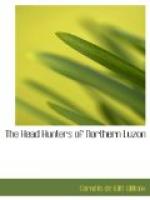Poor as we found the village on the material side, it has nevertheless some interesting institutional features. For example, it has sixteen wards, or atos, and each ato has its meeting-place, consisting of a circle of small boulders, where the men assemble to discuss matters affecting the ato, such as war and peace; for the ato is the political unit, and not the village as a whole. A remarkable thing is the family life, or lack of it rather: as soon as children are three or four years old, they leave the roof under which they were born and go to sleep, the boys in a sort of dormitory called pabajunan, occupied as well by the unmarried men, [37] and the girls in one called olog. And, as one may ask whether pearls are costly because ladies like them or whether ladies like pearls because they are costly, so here: Is the Igorot house so poor an affair because of the olog, etc., or does the olog exist because the house is poor? Be this as it may, and to resume, the children go on sleeping in their respective pabajunan and olog until they are grown up and married. A sort of trial marriage seems to exist; the young men freely visit the olog—indeed, are expected to. If results follow, it is a marriage, and the couple go to housekeeping; otherwise all the parties in interest are free. Marriage ties are respected, adultery being punished with death; but a man may have more than one wife, though usually that number is not exceeded. However, a man was pointed out to us, who maintains in his desire for issue, but without avail, a regular harem, having no fewer than fifteen wives in different villages, he being a rich man.
Among other things shown us by Father Clapp was a circle of highly polished boulders, said traditionally to be the foundation of the house of Lumawig, the Deity of the Bontok. One stone was pierced by a round hole, made by Lumawig’s spear: on arriving, he decided he would remain permanently in Bontok, and began by sticking the shaft of his spear in the stone in question—a very minor example, by the way, of his magical powers. More interesting, perhaps, than the ruins of Lumawig’s house was a sacred grove on a hill rising just back of the village, in which, according to Father Clapp, certain rites and ceremonies are held once a year. The matter is one for experts, but it appears strange that this people should have a sacred grove, as being unusual.
We wound up our stay in Bontok by going to a grand dinner in Government House, given by Pack. [38]
CHAPTER XX
We push on north.—Banana skirts.—Albino child.—Pine uplands.— Glorious view.
Our two days’ stay had greatly refreshed our horses and ponies, and they needed it, not only because of the work already done, but because of the effort we were going to ask of them during the next forty-eight hours, when the sum total of our ascents was to be 18,000 feet, and of descents the same, and the distance to be travelled seventy miles.




